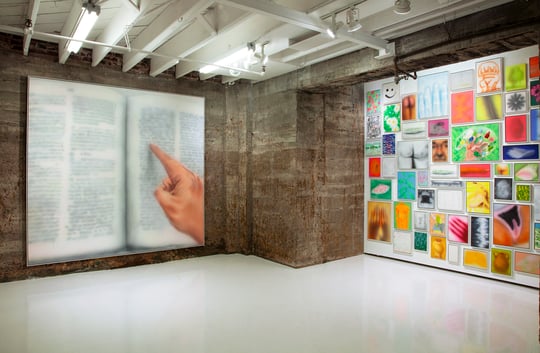
“Different Registers,” an exhibition featuring work by artists Caitlin MacBride, Sarah Tortora, and Derrick Velasquez, opened last Saturday night at the artist-run space Camayuhs in Atlanta’s Peachtree Hills neighborhood. The exhibition is guest curated by Lindsey Stapleton and Corey Oberlander, who recently relocated to Atlanta from Providence, Rhode Island, where their curatorial project GRIN occupied a brick-and-mortar space. Shortly before moving to Georgia, Stapleton and Oberlander, along with Boston-based BURNAWAY contributor and Big Red & Shiny editor Leah Triplett Harrington, launched The Rib, a decentralized online platform for criticism addressing art outside of major hubs like New York and LA. For Burnaway, Anna Nelson-Daniel, an Atlanta-based contributor to The Rib, speaks with Stapleton and Oberlander about the show, their move to the South, and the shifting structure of GRIN.
Anna Nelson-Daniel: When we first met you were conducting research on Atlanta’s art community for The Rib, which later led to my review of “Daydreams will last along into the night” at Hathaway. One thing that appealed to me about the mission of the publication was its unique aim to foster conversations about contemporary art outside of niche communities in major American cities. Before I moved back to Atlanta from New York, I met many artists who struggled with the increasing cost of living, in addition to costs associated with their studio practice. As a result, relocating to mid-sized cities has become the solution for many artists.
GRIN: During our tenure in Rhode Island, it wasn’t too difficult to feel connected to the universally recognized art worlds. Between various media channels, art fairs, and accessibility to criticism in major cities, it was relatively easy to keep up with what was going on in those places. However, learning what was happening in the smaller nooks, ours included, took a great deal of effort. We relied mainly on local outlets’ stretched-thin, pre-existing knowledge and word of mouth to learn about the various goings-ons.
With the decentralization of the artworld, a movement complete with conferences on how to keep artists in the big cities, the conversation seems to us to not necessarily be about the sheer number of arts professionals working outside major cities but instead the fact that it’s no longer quite so impossible to get exposure from outside of your immediate community. Much of the art world, even in any given local scene, is now experienced remotely.
With a strong enough internet presence and some e-elbow grease, gaining an audience and validation is within reach. Putting something out there that’s respected and enjoyed by peers far and wide is a rewarding experience on every given level. It seems that there is still a learning curve, and as more and more people take that leap and see how easily it may come (relatively compared to, say, 15 years ago), we’d hope that more projects will develop and continue to flourish in small communities. There is that whole pesky commercial bit which is, of course, the largest, hardest, and most specific hurdle to jump for some models. Exposure unfortunately doesn’t pay the bills, after all.
We’ve been advocates for small and mid-sized art communities since before the inception of our gallery, GRIN, in 2013, and for a while felt we had our finger on the pulse of like-minded projects. With that being said, during our initial research for The Rib and the subsequent communications we’ve had with artist-run spaces, writers, artists, and other institutions, we learned that we were dead-wrong. There is a ton happening around the entire country, and we’re constantly digging up exciting projects (new and seasoned) we’d never heard of. There are certainly art community deserts, but at this point, we find it hard to believe that any area is truly devoid of art and artists. Frankly, we’re struggling to keep up with it all!
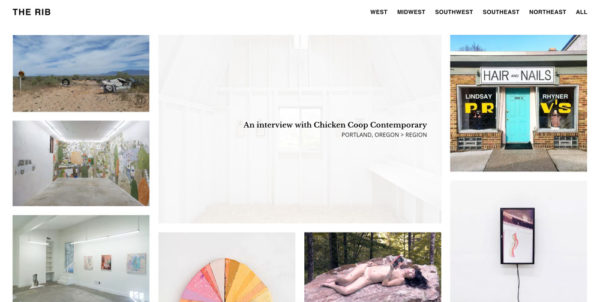
AND: What compelled you to relocate to Atlanta as opposed to other mid-sized American cities?
GRIN: We were in need of drastic personal change alongside our closing of GRIN’s brick-and-mortar, so we began searching for new opportunities. In the fall of 2017, we were able to secure seed funding via Common Field to launch The Rib later in the year, and a series of other fortunate events led us to Atlanta, where we also have some amazing family. We were very excited to learn about Atlanta’s vibrant artist community as outsiders looking in and were blown away when we arrived to see how much we’d missed from afar. It’s a very welcoming place, especially when compared to the Northeast! Moving to a new region has been instrumental in allowing The Rib to blossom and has enabled us to develop personal relationships with new artists, writers, galleries, and art-world advocates. While a lot can be done online, in-person interactions are still sometimes paramount to developing lasting relationships, professional or otherwise, and being in a new region lets us expand our immediate community even further.
AND: GRIN began as an artist-run gallery in Providence, RI, with the aim to promote work by emerging and underrepresented artists. It now runs as a curatorial partnership with spaces like Camayuhs. Is there a regional focus, or is it now designed to be free from regional boundaries?
GRIN: The mission of GRIN remains the same but now understandably emphasizes the conversation around place, or lack thereof. We’ve been working with concepts of contextualizing artists by location and aiming to purposefully cross-pollinate artists from different regions in exhibitions or projects in the same space. While curating, this can become an arduous and sometimes impossible task of marrying concept, aesthetic, location, and logistical and monetary needs, but that is the nature of these things most of the time. Without a consistent brick-and-mortar gallery, GRIN has transformed in a way that we believe will help us better serve the artists that we’re working with, and we’re excited to see where it takes us next.
We never aimed to be a provincial project or space and believe that it’s important to think and create on a universal platform (again, logistical needs aside). Both GRIN and The Rib, however, aim to elevate the conversation surrounding the artists and institutions making a go of it in small cities, even if we do ever end up producing a project in a large city again.
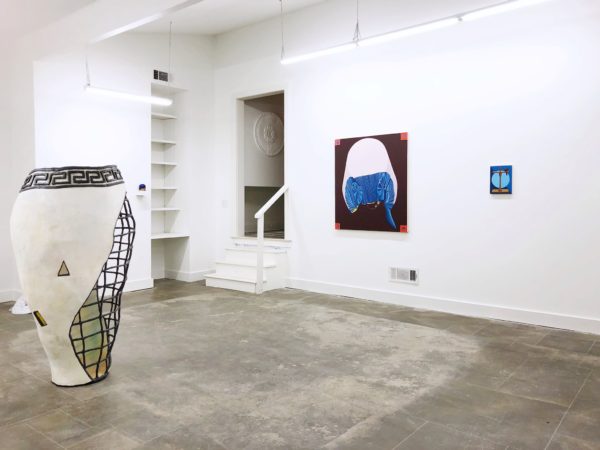
AND: In the past GRIN has participated in various art fairs. Do you envision that being part of your operations going forward?
GRIN: We would love to do more fairs in the future, but they are near impossibly expensive for the majority of small to mid-sized galleries. SPRING/BREAK Art Show was an unmatched experience for us when we participated in 2015, 2016, and 2017, and we’d do it again in a heartbeat. We also had great experiences at the more commercial fairs we did, like UNTITLED in Miami, and would be open to re-applying if the right partnership presented itself. We have similar notions for who we’ll work with for various curatorial efforts, but the beauty of our newly nomadic practice is that we no longer exist on a predetermined timeline.
AND: Along those lines, can you speak to plans for future exhibitions or programming?
GRIN: We’re still working to get our heads on straight after closing our space in Providence, and we want to work with people and venues with which we feel kinship. Meeting and working with Jamie Steele from Camayuhs has been the definition of something that just “felt right.” We love working with artists, gallerists, producers, and writers who are in-line with our personal ethos, and we have uncounted ideas in little notebooks ready to go once they find their proper homes.
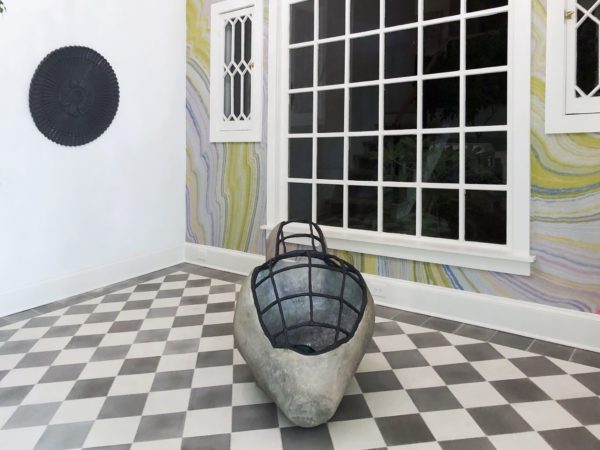
AND: “Different Registers” addresses the role of craft within contemporary art. Beyond this, the exhibition seems to build upon [Michael] Fried’s notion of objecthood as it renegotiates definitions and the value of Art with a capital A. How did this affect the works or artists you selected for the show?
GRIN: The question, “But is it Art?” is an old one with many varied and valid answers. For us, a sense of purpose has always been at the center of our evaluation. If something is made purposefully, we’re in. Each of the artists we’ve selected not only has an excellent personal sense of craft but also a personal appreciation for it. Sarah, Caitlin, and Derrick each have a record of making work that reflects their interest in art history and craft, and they use their formidable skillsets to combine contemporary interests with those of makers past.
We did a show with Sarah back in 2016 that dealt with archetypal and institutional modern forms that changed the way we thought about the architecture of gallery spaces. When we met Caitlin she was making stylized paintings and photographs of imagery from institutions she frequented. She’s focused her sights most recently on museum archives and visual hierarchies, altering the original imagery in a relatively minimal way and instead choosing to reconsider the presentation. Derrick’s work is a bit more humorous, parodying and challenging high-brow aesthetics, art, and architecture.
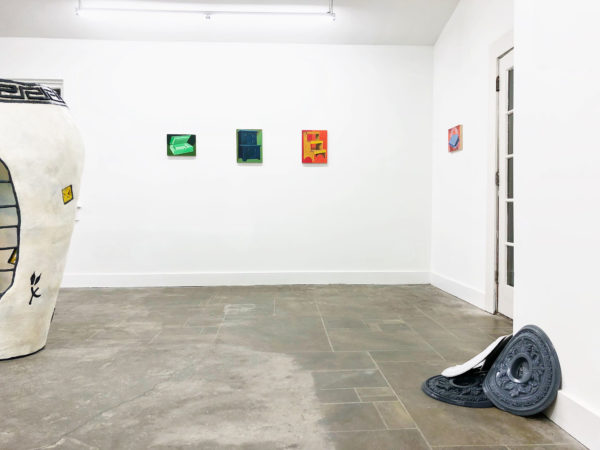
AND: Can you talk about your collaboration with The Neon Heater?
GRIN: Yes! Ian Breidenbach and Emily Jay of The Neon Heater have embarked on an incredible journey of organizing a 9-month exhibition series falling under a single linear story-ark. They will be producing 9 exhibitions at their space in Findlay, Ohio, but have also involved dozens of other associated exhibitions at like-minded spaces across the entire country. Our exhibition is part of the inaugural exhibition running through September themed “The Setting” alongside four others including SouthernExposureProjectSpace in St. Augustine (FL), River House Arts in Toledo (OH), with both Usable Space and The Real Tinsel in Milwaukee (WI). We are so excited to be a part of it!
AND: Is there anything else you’d like to add about your experience curating the exhibition?
GRIN: We highly recommend the essay that inspired the exhibition: Eleven Propositions in Response to the Question: “What is Contemporary about Craft?” by Julia Bryan-Wilson.
In partnership with Ohio-based gallery The Neon Heater, “Different Registers” is one of the first in a nine-month-long series of related exhibitions taking place across the country. The show remains on view at Camayuhs in Atlanta through October 6.



